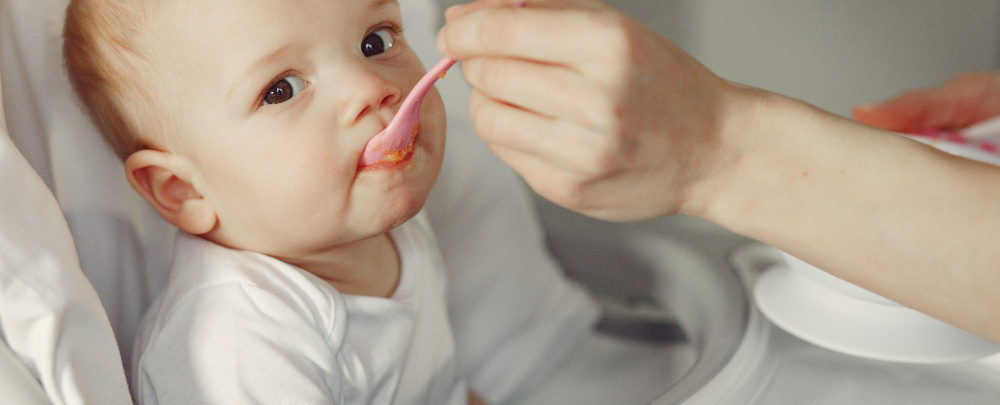As you start thinking about the exciting new world of weaning, it’s important not to forget that any food you serve needs to be safe. Babies and young children don’t have the same immune system as us adults (or even older children) so we need to make sure we’re extra careful with their little tummies!
It is estimated that there are 2.4million cases of food borne illness in the UK every year so here are some of my top tips on what you can do whilst cooking, reheating and defrosting food to help make sure the food you serve your little ones is safe!
Hygiene
When preparing food for your little one, making sure you’re preparing food on a clean surface, with clean hands, using clean equipment is essential!
- Wash your hands – Always wash your hands thoroughly before preparing any food, and after handling raw meat
- Clean work surfaces – Disinfect food preparation surfaces using a clean dishcloth before starting any food preparation. If you can, use a paper towel squirted with anti-bacterial spray to clean surfaces after preparing raw meat and poultry as this will help make sure that you don’t pick up food poisoning germs and spread them around the kitchen!
- Clean utensils – Make sure equipment is clean before you start using it and if you can, opt for colour coded equipment to reduce the risk of cross contamination between raw and ready to eat foods. Never prepare ready to eat food such as salad on a board that was previously used to prepare raw meat.
- Wash fruit and Veg – They might be low risk foods, but bacteria can also be found on fruit and veggies too so don’t forget to wash these thoroughly under cold running water before serving to baby. If you’re using frozen veggies in baby’s food, make sure that these are cooked before serving to your baby according to the back of pack information.
- Don’t be tempted to wash raw chicken! Washing your chicken will not ‘wash off’ the bacteria (only cooking will make it safe to eat!). If you wash chicken, you are instead more likely to cause food poisoning by inadvertently spreading more bacteria around the kitchen.
Cooking for Baby
Cooking veggies by steaming/ boiling or roasting is pretty straightforward, but those first tastes don’t last for long and you’ll soon be branching out to more exciting combination foods for your baby to try, many of which may include meat or fish. Regardless of how you serve meat to your little one, it’s important to make sure that it is thoroughly cooked!
Remember – Just because it’s cooked on the outside, doesn’t mean it is cooked on the inside! Here’s how you can check that meat is safe to eat…
- Use a food probe – Checking the temperature of the thickest part of meat is the most accurate way (and the way I would recommend) to check food is cooked, whilst also making sure it is not overcooked! If using a probe, make sure the probe is clean and the meat has a core temperature of 75C for at least 30 seconds.
- Cut into the thickest part of the meat to make sure there is no pink meat visible
- The meat must be steaming hot throughout
- Meat juices run clear
What to do with leftovers?
Babies have little tummies and a daily changing appetite! I am a huge fan of keeping leftovers to use as an easy meal another day so after cooking, make sure you cool any leftovers quickly and pop them into the fridge or freezer as soon as possible. Never allow food to sit out on the side for more than 2 hours after cooking. (Make sure you cool any leftovers you want to keep as quickly as possible, but always within 2 hours (Follow @Foodsafetymum Instagram page for some tips on how to cool food quickly!)
- Any leftover food can be kept in the fridge and used within 2 days (1 day for rice dishes) but if you want longer than this, then make sure you pop your leftovers in the freezer!
- Remember though that foods can only be reheated once so make sure you divide your puree into baby friendly portions before storing in the fridge or freezer!
Even if you used raw meat or veg which was previously frozen, once cooked you can freeze the leftovers!
Defrosting Purees
If defrosting baby purees, the best way to do this would be overnight in the refrigerator and use within 24 hours…
But, did you know that you can cook baby purees from frozen?!
Reheating Leftovers
Unless served cold straight from the fridge, leftover foods for baby should always be reheated until piping hot; which means steaming throughout. Don’t be tempted to just partially reheat food for your baby to avoid having to wait for it to cool!
Just make sure that if you’re cooking a portion of baby puree from frozen, make sure you increase the cooking time and stir regularly (every 20-30 seconds) to ensure there are no hot spots and that the puree is evenly heated, so it is piping hot throughout.
Remember though that foods should only be reheated once so make sure you divide your puree into baby friendly portions before storing in the fridge or freezer!
Hopefully you find this blog useful in helping you prepare for the weaning journey with your little one! For more information, follow Jenna on Instagram @Foodsafetymum




Leave a Comment
You must be logged in to post a comment.